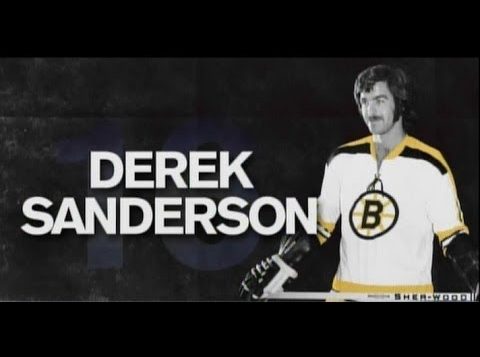This Day in Hockey History – June 16, 1946 – Turk’s Day
Derek Sanderson, who enjoyed the rush and roar of the crowds, was born near the roar of rushing water, at Niagara Falls, Ontario, on June 16, 1946. Just 21 years later, he won the Calder Memorial Trophy as NHL rookie of the year. He would go on to win two Stanley Cup championships with the Boston Bruins, each just a month before turning 24 and 26. Eight years after playing his last NHL game two months shy of his 32nd birthday, Sanderson went on to become a TV analyst for the Bruins and then a financial advisor. He wrote in his autobiography, “I lived well and I lived hard.”
In the midst of World War II, Canadian Harold Sanderson met Caroline Gillespie in Scotland, where he had been sent to recover from an injury. Harold wooed Caroline in letters sent from the front, and she had their daughter while he served in France. With the end of the war, the family moved to Canada shortly before Derek’s birth. Harold decided his son would become a hockey star, so Derek began skating at the age of 8 and received an expensive pair of skates at 12 with the promise that he would give his dad a Stanley Cup ring someday.
Sanderson’s teammates soon began calling him Turk. As a teen, Sanderson played for the Niagara Falls Flyers and helped them win the Memorial Cup as Canada’s best junior team in 1964-65. The next season, he took home the Eddie Powers Memorial Trophy as top scorer of the Ontario Hockey Association. At an exhibition game at Boston Garden, he fought Bobby Orr just to get noticed. Despite being opposites, the two would become lifelong friends.
After playing a couple of games with them, 21-year-old Sanderson officially joined the Boston Bruins for the 1967-68 season. He took the No. 16 sweater when its 1950s wearer, “Leo the Lion” Labine, said, “Let Sanderson wear my number, because he’ll toughen it up.” Indeed, he was an agitator and tough, leading the charge of the Big Bad Bruins. But he was also really good at penalty kills (with Ed Westfall) and scored many shorties. With his 24 goals (two shy of the record at the time) and 49 points, Sanderson received the Calder Memorial Trophy. Orr had just earned it the season before, so they became the only teammates to win back-to-back.
The teamwork between the two stars directly led them to the 1970 Stanley Cup, the Bruins first championship in 29 years. The passing from Orr to Sanderson and back to Orr resulted in perhaps the most famous game-winner in NHL history. They followed that up with another Cup victory two years later, this time against their biggest rival at the time, the New York Rangers.
With the arrival of the WHA in 1972, Sanderson asked the Bruins for $80,000, twice his annual salary. When they refused, he signed a contract with the Philadelphia Blazers for a record $2.6 million. That made him the highest-paid athlete in the world. However, in Philadelphia’s home opener, the Zamboni ruined the ice forcing the cancelation of the game. When Sanderson, the team captain, came out to apologize, fans threw their souvenir pucks at him. After only eight games, Sanderson was out with a back injury. His behavior led the Blazers to pay him $1 million not to return.
In February 1973, 27-year-old Sanderson returned to the Bruins. He only lasted one tumultuous year there until he refused to return to Boston with the team after a road game. The Bruins suspended him and traded him to the Rangers. Dashing their hopes of using the one who riled up their fans for their benefit, Sanderson was undisciplined in his health, attitude, and performance. The Rangers traded him to St. Louis, where he had a career high of 67 points (24G, 43A) in 1975-76. He resumed his substance-abuse behaviors the next season, so he was sent to the minors then traded to Vancouver in February 1977. After mere weeks, he was back in the minors. Sanderson had one last hurrah in the NHL when he finished out the 1977-78 season with the Pittsburgh Penguins.
After about three terrible years as an alcoholic addict, losing money, and living on the streets of New York City, Sanderson finally made it through rehab in 1980. While going through hip surgeries, in 1984, he was recruited by Boston’s mayor to speak to students about substance abuse. Two years later, at age 40, Sanderson became a TV broadcaster for the Bruins. For the next eleven years, he partnered with Fred Cusick, who had called the 1970 Stanley Cup Final. Their highlights included covering the last game at the old Boston Garden and the first game at the new Fleet Center. Around the same time, 40-year-old Sanderson passed an exam qualifying him to be a financial advisor. He set up the Sports Group with three goals – to “protect athletes from themselves,” to help athletes not be taken advantage, and to “educate players.”
In the conclusion of his autobiography, Sanderson summarized everything in one long sentence. “In the span of an extraordinary life, I made the National Hockey League, won two Stanley Cup championships, became a trendsetter, gained celebrity status, became a millionaire, descended into addiction, was homeless, almost died, asked for salvation, kicked booze, drugs, and cigarettes, climbed back from the wreckage, met an amazing woman who gave us two great sons, taught kids about the evils of addiction, was a broadcaster and now advise athletes about their finances.” As he put it, “That’s a lot to pack into one life!”
Additional Sources:
- “Center of Attention: The Unreal Life of Derek Sanderson,” NBCSN, 2015.
- Derek Sanderson, Crossing the Line: The Outrageous Story of a Hockey Original(Triumph Books, 2012).














